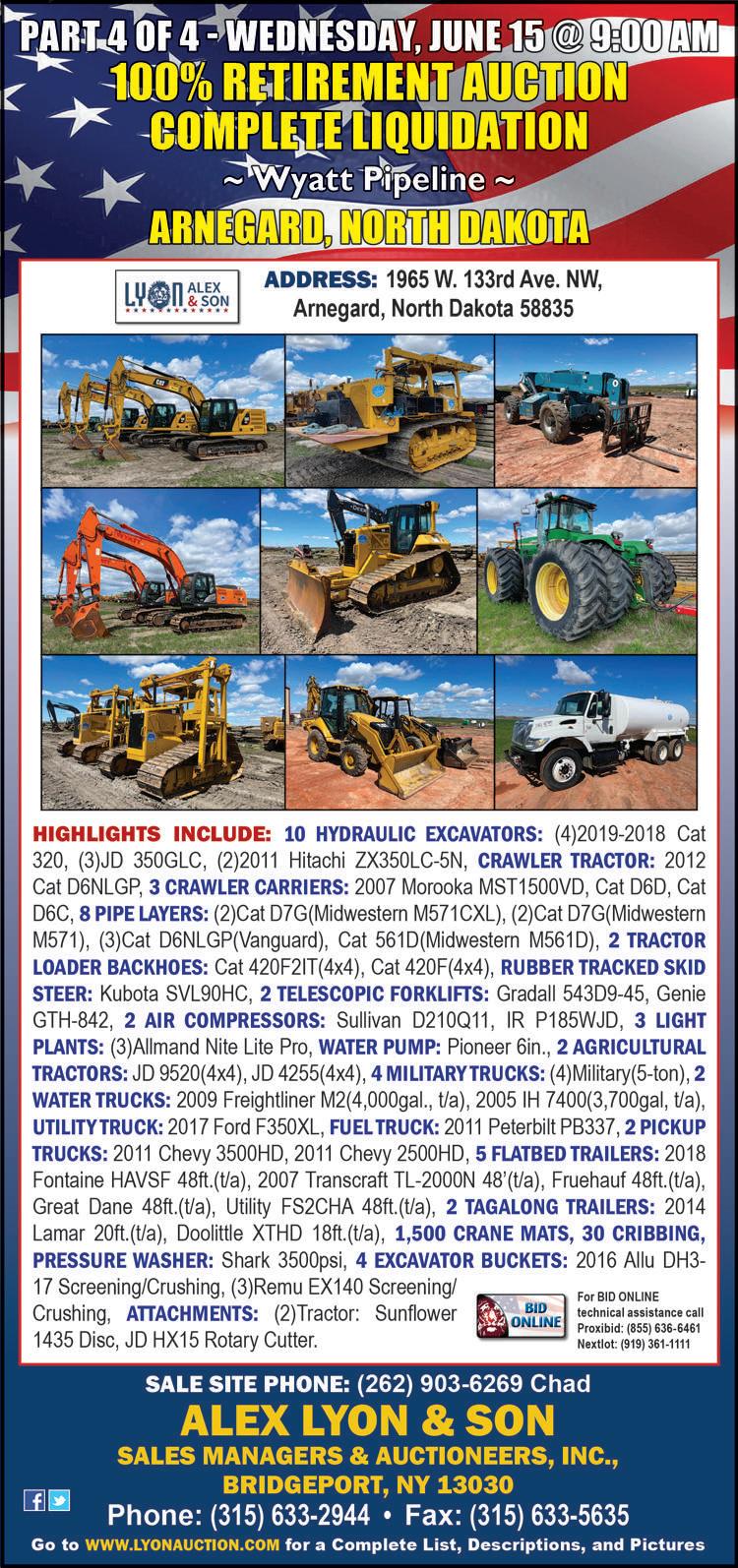
5 minute read
RITCHIE DISCONTINUES ACQUISITION ATTEMPT OF EURO AUCTIONS
TECHNOLOGY from page 8 ably going to be stuck in about a one-foot area.”
The result will be a more concentrated load on the pavement within that area, which said will change a bit in how pavement is designed in order to hold that load.
The pavement “will have to be stiffer. We’re still researching how those effects can cause those problems with those vehicles.”
Autonomous vehicles also are at the heart of research into keeping road workers safe.
Last year, the North Dakota Department of Transportation launched an autonomous protection truck for road construction crews in work zones.
Kevin Longley of the American Society of Civil Engineers (ASCE) reported that the state utilized a grant from the Federal Highway Administration to improve work zone safety with an “autonomous impact protection vehicle.”
Impact protection vehicles, driven by humans, protect construction crews from other drivers on the road who are not paying attention to the construction site or have lost control of their vehicle.
A crew member will remotely control the autonomous vehicle, but no humans will be inside during shifts.
“This is a great day for North Dakota to showcase its commitment to innovation,” said NDDOT Director Bill Panos in announcing the program. “This technology is one more tool that we will have available to enhance the safety of work zones in our state.”
The state DOT believes the autonomous vehicle, dubbed the Autonomous Truck Mounted Attenuator (ATMA), will improve safety in work zones by removing the driver from the impact protection vehicle during normal operation.
“The NDDOT remains committed to its Vision Zero initiative and our goal is to eliminate fatalities and serious injuries caused by motor vehicle crashes,” said Panos.
According to ATMA developer Kratos Defense, highway workers are at especially high risk when assigned to drive an impact protection vehicle.
The truck follows behind slow-moving highway maintenance vehicles as a humandriven mobile crash barrier, absorbing the impact of traffic accidentally entering the work zone.
“Driving a TMA is extremely dangerous and drivers are at serious risk of lifelong injury, painful rehabilitation and even death,” said Maynard Factor, business development director of Kratos. “To eliminate this dangerous assignment, Kratos Defense developed the Autonomous TMA [ATMA] by retrofitting standard TMA vehicles with driverless technology to enable unmanned operation.”
The first ATMA systems were deployed in 2017 and have since then been deployed across the United States and Europe.
The unmanned vehicle operates in a multi-vehicle leader/follower configuration with a human driven highway maintenance vehicle, the company said.
In the leader/follower configuration, the system enables the maintenance vehicle, or leader, to transmit navigation data via encrypted V2V communications to the ATMA as the follower.
From there, the ATMA uses the data to follow the leader, unmanned, as it travels along the route.
The ATMA systems features component redundancy, an active safety system, high accuracy GPS/GPS-denied navigation, encrypted V2V communications, and multimodal front and side-view obstacle detection, the companies added.
It also includes a user interface that provides system feedback, situational awareness, multi-camera views and operator controls, according to Kratos.
“These vehicles follow road crews and create a physical barrier between workers and the public that can save a life in the event of a work zone intrusion,” said Terry O’Sullivan, general president of Laborer’s International Union of North America. “Remotely operated equipment protecting the work zone could potentially eliminate deadly work zone intrusions and that is a positive step for work zone safety.”
The Colorado Department of Transportation began using automated TMAs in 2017 after recording 26 incidents of motorists crashing into the vehicles over a four-year period.
Usually unoccupied when protecting a stationary work site, these vehicles have workers following alongside as paving jobs progress.
CDOT began using a remote-controlled impact protection vehicle operated by a driver in another truck traveling ahead of it.
If the wireless connection is lost, the driverless vehicle automatically comes to a stop. If the vehicle with the TMA is hit, there’s nobody sitting in the cab that can be injured.
“People often talk about the coming job displacement of automated vehicles — well this is actually one job I want to get people out of,” said Shailen Bhatt, executive director of CDOT. “The idea that we have a truck (whose) job is to get hit, with someone sitting in it, well that doesn’t make a lot of sense.”
CDOT tried out the driverless TMA on a road striping project in Fort Collins and plans to use it on other projects.
The department believes the technology has the potential to improve work zone safety now and productivity in the future as automation frees up workers to take on other tasks.
Bhatt believes technology “can take transportation safety to a new level and forever improve the way we work. By using self-driving technology, we’re able to take the driver out of harm’s way while still effectively shielding roadside workers.” CEG
Driverless impact protection vehicles, controlled remotely by humans, protect construction crews from other drivers on the road who are not paying attention to the construction site or have lost control of their vehicle.
Ritchie Bros. Auctioneers announced that its wholly owned indirect subsidiary, Ritchie Bros. UK Holdings Ltd. (“RB Purchaser”) is discontinuing the Phase 2 review by the UK Competition and Markets Authority (the “CMA”). The Sale and Purchase Agreement dated Aug. 9, 2021 (the “Agreement”) pursuant to which the RB Purchaser had agreed to purchase Euro Auctions Limited, William Keys & Sons Holdings Limited, Equipment & Plant Services Ltd and Equipment Sales Ltd. will automatically terminate on June 28, 2022.
The decision follows the referral of the proposed acquisition to a Phase 2 review by the CMA. Amongst other things, completion of the Agreement is conditional on receipt of clearance from the CMA on terms satisfactory to the RB Purchaser, but after extensive consideration the RB Purchaser does not believe there is any realistic prospect for approval by the CMA on such terms given the significant concerns raised by the CMA to date.
The company intends to issue redemption notices with respect to the $600 million aggregate principal amount of 4.750 percent senior notes due 2031 and the C$425 million aggregate principal amount of 4.950 percent senior notes due 2029 previously issued to finance a portion of the cash consideration for the proposed acquisition and expects to complete the redemptions within 10 business days.
Ann Fandozzi, the company’s chief executive officer, said: “We are disappointed by the decision taken by the CMA to refer the proposed acquisition to a Phase 2 review and respectfully disagree with their views. While we believe the proposed acquisition would have accelerated our strategy, we remain committed to forging ahead in our transformational journey to become the trusted global marketplace for insights, services and transaction solutions. We will continue to seek out and execute on organic investments and key acquisitions to accelerate our pace in achieving our ultimate vision.”
For more information, visit RitchieBros.com.










